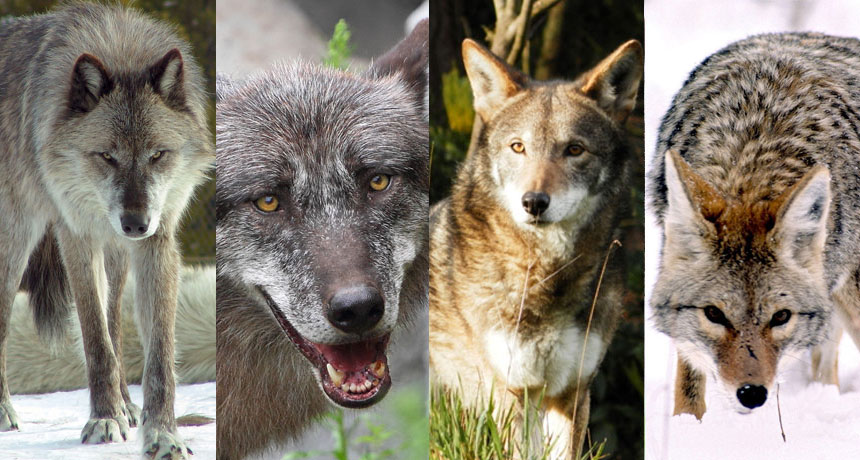Wolf species shake-up
Genetic study says coyotes and gray wolves combined to make other canines

Eastern wolves (second from left) and red wolves (second from right) might not be distinct species. A new genetic analysis suggests they’re mixtures of gray wolves (far left) and coyotes (far right).
FROM LEFT: DENNIS MATHESON/FLICKR (GRAY WOLF); STEFFEN239/FLICKR (EASTERN WOLF); CHRISTINE MAJUL/FLICKR (RED WOLF); MAV/WIKIMEDIA COMMONS (COYOTE)
Wolves are having an identity crisis. A new genetic analysis suggests that red wolves and eastern wolves aren’t true “species.” Instead, they seem to be blends of two other species, gray wolves and coyotes.
Gray wolves used to roam much of North America — until they were hunted almost to extinction. In 1973, a new law called the Endangered Species Act made it a crime to harm animals such as the gray wolf. That protection has helped gray wolves to bounce back. But their current range is still far smaller than it used to be.
Red wolves and eastern wolves look similar to gray wolves but are often treated as different species. Eastern wolves live in the Great Lakes region, where gray wolves are now scarcer. Red wolves call the southeastern United States home. That’s a region where gray wolves no longer exist.
The new study looked at the entire genetic makeup, or genome, of 23 wild canines from around North America. The researchers compared the genomes in these individuals to those from pure coyotes and Eurasian wolves. That let them figure out how much of each animal’s genetic material came from wolves or coyotes.
Red wolves have about 75 percent coyote genes and just 25 percent wolf genes, they found. Eastern wolves have about 25 to 50 percent coyote ancestry. The international team of scientists reported its finding online July 27 in Science Advances.
The new data mean that both red and eastern wolves have mated with coyotes in the past. Gray wolves also have some coyote genes. And eastern wolves and red wolves are just as closely related to gray wolves as they are to other members of their species. That suggests these three wolf groups are more evolutionarily related than scientists had thought, says Robert Wayne. He’s a biologist at the University of California, Los Angeles. He also coauthored the study.
Red wolves and eastern wolves probably first appeared when early settlers hunted gray wolves in the eastern United States, says Doug Smith. He’s a biologist who leads the Wolf Restoration Program in Yellowstone National Park, Wyoming. Killing off some gray wolves made room for coyotes to move east. There they likely bred with struggling wolves. Mixing their genes with coyotes probably helped wolves survive when times were tough.
Labels and laws
What difference does all this make? Potentially quite a lot. And here’s why.
Wolves in the United States are protected by different laws depending on where they live. Red wolves are listed across the whole nation as endangered with extinction. But gray wolves are only listed as endangered in some places. One such place is the upper Midwest. Elsewhere, it’s legal for hunters to kill gray wolves. Genetic mixing between different kinds of wolves makes it even harder to create laws to protect them.
Red wolves and eastern wolves look slightly different from gray wolves because of their coyote genes. But “we don’t find anything incredibly unique in the red wolf that you can’t find in other canines,” says Bridgett vonHoldt. She’s a biologist at Princeton University in New Jersey. She also worked with Wayne on the new study.
Still, vonHoldt adds, red wolves are important to protect. “The wolf part of their genome might actually represent the last of the southeastern gray wolf,” she says. It’s a similar story for the eastern wolf.
Blended species like these are hard to label, Smith admits. Usually, when animals are defined as separate species, it means they have boundaries that keep them from mating with each other. “Nothing isolates a wolf,” though, says Smith. “They’re just so capable of moving around.”
So the blended genetics of these canines adds a new twist to an ongoing battle over wolf protection in the United States. How can we protect a group of animals that’s not its own species, but carries valuable genetic information?
“These animals don’t walk around with little name tags on them in the field,” says vonHoldt. So animals with mixed-up ancestry “don’t always look very different from a pure coyote or pure wolf.”
The only way to make sure wolf genes stick around in certain areas would be to ban the killing of both wolves and coyotes in those places, vonHoldt says. That would keep someone from accidentally killing a wolf that looks like a coyote. Such laws, however, would be nearly impossible to enforce, she adds.
This study is an important step, says Paul Wilson. He’s a biologist at Trent University in Ontario, Canada. But he doesn’t think it’s the final word. According to his own research, the eastern wolf still deserves to be its own species. He says looking at DNA from ancient North American canines — before wolves and coyotes ever mated with each other — could help clear things up.







